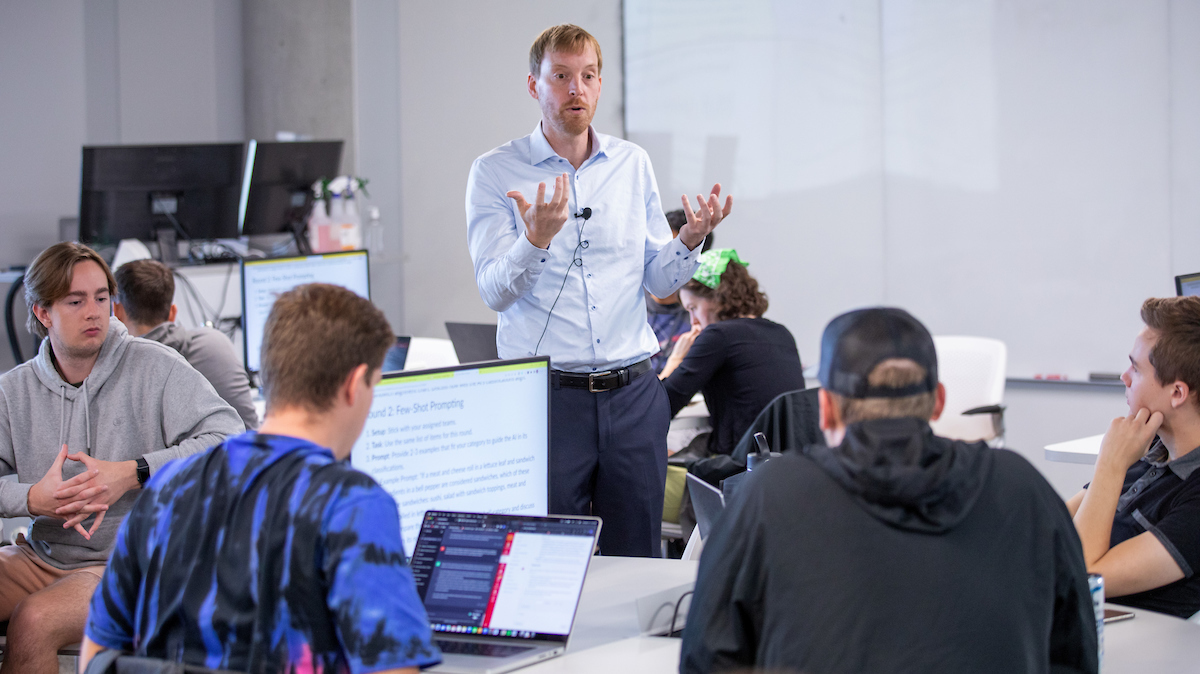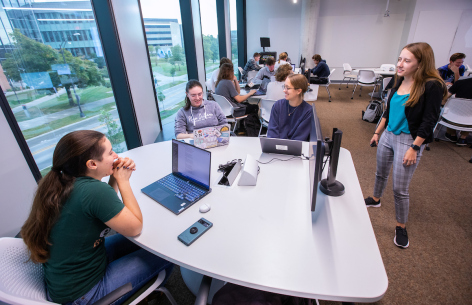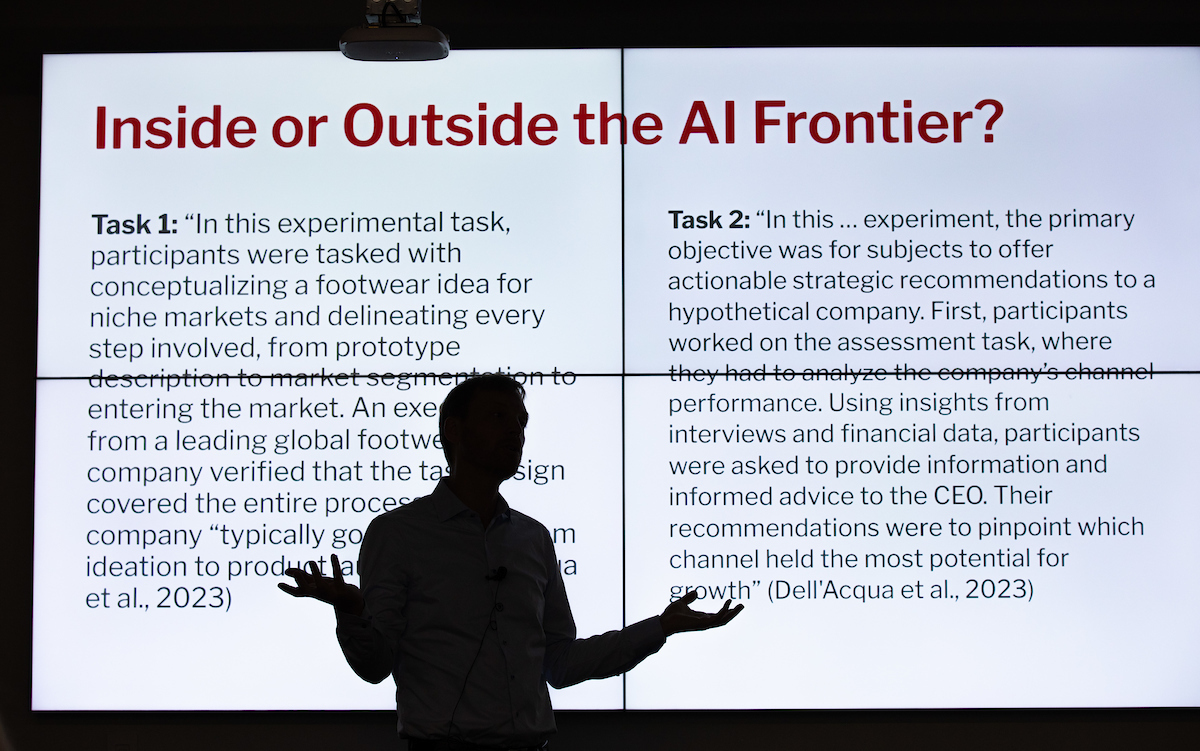
Abram Anders, associate professor of English and interim associate director of the Student Innovation Center, co-instructs the experimental course "Artificial Intelligence and Writing." Larger image. Photos by Christopher Gannon/Iowa State University.
AMES, Iowa – In the Student Innovation Center at Iowa State University, students cluster around tables and pull out their laptops. It’s the fifth week in "Artificial Intelligence and Writing," a new, experimental course to explore large language model–based chatbots, like ChatGPT.
Associate professor of English Abram Anders explains the day’s class will focus on prompting techniques. During one of the exercises, the students type "write a song about college" and then compare the AI-generated lyrics with results from prompts that are more specific. One student adds "punk rock" in her request. Another asks for lyrics in the style of Eminem.
From here, the class moves on to more complicated "chain-of-thought" prompting. Anders explains this format combines instruction with several examples and reasoning. He shows how it works with a math problem before the students apply it to the "sandwich alignment chart," a popular meme from 2017.
"Every day, I find myself saying, 'I'm so excited.' Our students are having fun, and it’s this great opportunity to discover and experiment together," says Anders.

Co-instructor Emily Dux Speltz checks-in with a group of students. Larger image
In this inaugural class, 31 students represent majors from across campus and range from freshmen to graduate students. Emily Dux Speltz, a Ph.D. candidate in applied linguistics and technology, helped develop the curriculum with Anders over the summer and is one of the co-instructors.
Dux Speltz says some students signed up for the class because they “love AI” and wanted an opportunity to experiment. Others, like Hanna Burr, a graduate student in the creative writing and environment program, registered because they had concerns about AI.
"I've been nervous about AI taking over my skillset as a writer and communicator for the past few years," says Burr. "But what I've learned is that AI, at least in its current form, can't replace writers or fully take over tasks in any field. It needs guidance and clear instructions."
For AI to be a useful tool, Burr says people need to understand how to leverage it within their area of expertise.
"Personally, it’s made my research much more efficient because AI can give me a list of the most relevant, credible sources about a topic, along with short summaries. It completes in 20 seconds a task that might take me hours of scrolling through Google Scholar," she explains.
Dux Speltz and Anders say they want their students to experiment with AI in ways that feel relevant. Earlier in the semester, a student interested in fiction writing used ChatGPT to help develop characters and plot points. Others prompted AI to help them create and stick to goals for the semester.
"One student said they felt like they were a good writer but didn’t have great sentence variety. So, they asked AI to give suggestions from their writing with illustrative examples," says Anders. "It wasn’t just 'fix my writing.' It was, 'help me learn how to be a better writer.'"
At the end of the semester, each student will work on a larger, creative project that combines multiple AI tools. Anders and Dux Speltz say the multimodal text could be anything from a pitch proposal for an AI-based entrepreneurial venture to a video essay exploring the future of AI-assisted writing. The project will culminate in a class presentation, in which students will explain their strategies and reflect on the process.
Bringing a competitive edge
On track to graduate this spring, Burr underscores that the skills she’s learning in this class will give her a boost as she applies for jobs. The sentiment is echoed by Dux Speltz.
"I’m looking for assistant professor of English positions, and there are a lot of jobs out there saying 'an interest in generative AI is preferred,'" says Dux Speltz. "I’m seeing new jobs popping up that are specifically looking for people with skills in AI, but really, learning how to use these tools can benefit and help prepare students in any discipline."

Anders asks students to analyze the results from a new white paper. Larger image.
Dux Speltz and Anders point to research showing a host of industries and roles will be transformed by AI. But they emphasize that new writing technologies have changed how people work and communicate throughout history. The typewriter played a key role in bringing women into offices in the 20th Century, says Dux Speltz. While word processors dried up the need for typists, women did not drop out of the workforce. Instead, they moved into new and higher-up positions.
Anders says the internet offers another example of technology that has radically changed the nature of work and created new jobs.
"We want to point out to students that AI tools will be absolutely transformative, and opportunities tend to grow overall as this more sophisticated technology leads to more sophisticated and complex knowledge work and economic activity," says Anders. "We certainly see many reasons to be concerned, to be wary, to emphasize ethics, but on the whole, I tend to be on the side of a technology optimist."
Anders says empirical studies show generative AI tools can improve productivity for coding, writing emails, developing reports and planning marketing campaigns.
"But with all of these examples, it really relies on people knowing how to use the tools correctly and being cognizant that there are some exceptions there," says Anders.
Research and sharing best practices
Because AI tools like ChatGPT and Bing are new and quickly evolving, Dux Speltz and Anders envision multiple research opportunities going forward. This includes studying how people who use AI change the way they break apart tasks and think more broadly about their work.
"In order to use these tools well, you have to have a more rigorous conception of your intention; how you’re evaluating the result, what your goal is, what the pieces are, and in the moment, you have to be good at responding to what’s actually happening. This is what expert learners, innovators and entrepreneurs are really good at," says Anders.
The researchers also want to share what they learn from developing and teaching "Artificial Intelligence and Writing" with other instructors.
On October 13, from 1 – 2 pm, Dux Speltz and Anders will present: "How to teach with generative AI: Supporting students and designing learning experiences" through Iowa State’s Center for Excellence in Learning and Teaching. The virtual event is free and open to the public.
Anders says the presentation is part of a larger effort at Iowa State to think about how AI can be integrated into higher education.
Contacts
Abram Anders, English, adanders@iastate.edu, 515-294-3217
Emily Dux Speltz, English, endux@iastate.edu, 515-294-2180
Rachel Cramer, News Service, rcramer@iastate.edu, 515-294-6136
Quick look
Iowa State students are exploring generative Artificial Intelligence tools and techniques in a new, experimental class this fall. The researchers who developed the curriculum say it’s part of a larger effort at the university to equip students with competitive skills and talents as they enter the workforce.
Quotes
"We want to point out to students that AI tools will be absolutely transformative, and opportunities tend to grow overall as this more sophisticated technology leads to more sophisticated and complex knowledge work and economic activity."
Abram Anders, English
"I’m seeing new jobs popping up that are specifically looking for people with skills in AI, but really, learning how to use these tools can benefit and help prepare students in any discipline."
Emily Dux Speltz, English
More news
Find more Iowa State University news and research stories at news.iastate.edu.